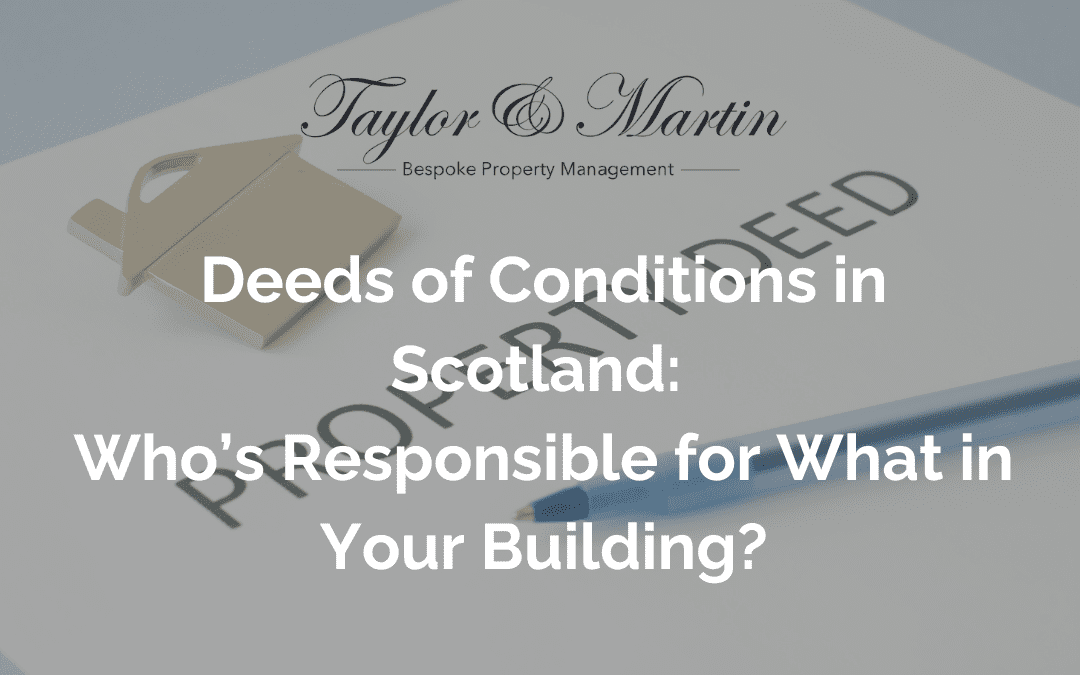Many homeowners in Scotland – particularly those living in flats, tenements, or new developments – aren’t always sure who is responsible for repairs, insurance, and communal upkeep. Is it down to you, your neighbours, or the property factor?
The answer lies in the Deed of Conditions which is part of your Title Deeds, The Deed of Conditions should set out exactly who is responsible for what. This is not only important for you as a homeowner, but is also important for the property factor to understand. At Taylor & Martin, we interpret these deeds on your behalf to ensure fair charging, proactive maintenance, and stress-free management.
What Are Deeds of Conditions in Scotland?
Your title deeds are the legal documents that prove ownership and outline the boundaries of your property. Within these, you’ll often find the Deed of Conditions — a legally binding set of rules that applies to all homeowners in the building or development.
The Deed of Conditions typically covers:
- Which parts of the building or grounds are “common” and shared
- How repair and maintenance costs are divided
- What each homeowner must contribute towards communal upkeep
- The duties and powers of the property factor (if one is appointed)
- Rules and restrictions, such as alterations or use of common areas
Because these conditions are registered against the property, they apply to you automatically when you buy your home.
When the Deed Doesn’t Cover Everything
Sometimes Deeds of Conditions are unclear, outdated, or missing details. In these cases, Scottish law provides a fallback:
- Tenements (Scotland) Act 2004 – sets out the Tenement Management Scheme, which gives default rules for shared maintenance and decision-making.
- Title Conditions (Scotland) Act 2003 – governs “real burdens” and explains how conditions can be changed or removed.
The development management scheme (DMS) was introduced by the Title Conditions (Scotland) Act 2003 with the intention of reducing disputes over maintenance, repairs and other issues affecting new build developments where owners share common property.
Owners of the land on which the development is built must register the scheme in the Land Register using a deed of application.
The legislation provides a template for the scheme, which can be varied to suit the needs of different developments.
These laws protect homeowners and ensure essential repairs can still be carried out fairly, even if the deeds are silent.
It’s important to note that there is not a standard Deed of Conditions for property in Scotland and Deeds will vary in terms of what is covered as common property and how costs are apportioned. Solicitors, at the point of purchase, should explain to the purchaser what the potential liabilities are for each property.
In order for the rules of the scheme to apply, the owners or co-owners of the land on which the development is built must register the scheme in the Land Register.
How Costs Are Shared
Your Deed of Conditions should set out how costs are divided. This is often equal shares per property, but can also be based on floor area or benefit from a particular service e.g. lifts. Some older Deeds may refer to old rateable value which, in turn, are based on floor area.
At Taylor & Martin, we ensure:
- Fair apportionment – always following the deeds
- Transparency – clear invoicing showing what you’re paying for
- Competitive value – using trusted contractors and, where appropriate, multiple quotes
- Forward planning – budgeting for cyclical works so there are fewer surprises
How Taylor & Martin Support Homeowners
We know legal documents can be daunting, so we handle the interpretation of deeds and ensure everything is carried out fairly and in line with Scottish law. Our approach includes:
- Careful review of deeds when we take on a development
- Clear Written Statement of Services for all owners
- Regular inspections and proactive maintenance planning
- Competitive tendering for larger works
- Transparent communication on costs and decisions
- Guidance and support when disputes or unclear deed provisions arise
Key Takeaways for Homeowners
- Always keep a copy of your title deeds and Deed of Conditions
- Understand how costs are apportioned in your building
- Check your Written Statement of Services from your factor
- Attend owners’ meetings and ask questions about budgets and maintenance plans
- Remember that Scottish law provides fallbacks if deeds are silent
Understanding your Deed of Conditions is the first step in knowing your responsibilities — and your rights — as a homeowner in Scotland. With Taylor & Martin as your factor, you can be confident that deeds are interpreted correctly, charges are fair, and your building is maintained to a high standard without unnecessary stress.

